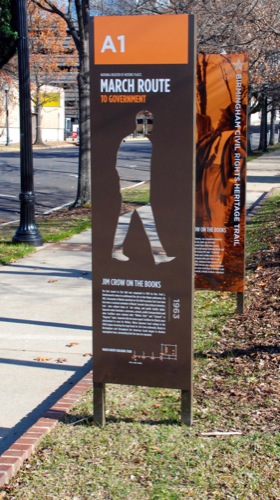
Courtesy Greater Birmingham CVB
“I’m glad to hear that,” he said. “To answer your question, let me say that we’re focused on several things for 2013, including the completion of our civil rights trail signage for our visitors and the commemorative weekend in September that honors the lives of those young girls who were killed on Sept. 15, 1963.”
Faush, like Hamlin, sees a present-day Birmingham that will overcome any remaining doubts visitors might have about the transformation of this city over the past 50 years.
“When all is said and done,” said Faush, “we want our city’s brand to flourish. We want our guests to understand that where once we were industrial, now we’re a medical center. Where once we stood for hatred, we now stand for human rights.”
It was ironic that parts of the movie “42” were being shot while I was in Birmingham. The movie is about the life of another pioneer, Jackie Robinson, who broke the color barrier in major league baseball in 1947.
Birmingham’s historic Rickwood Field is the site for some baseball scenes in the movie, which debuts i n 2013. I toured the Birmingham Civil Rights Institute with a young man with the film company who was doing research in the city.
At the 16th Street Baptist Church, I met with Rev. Arthur Price Jr., who showed me the church’s beautiful Wales Window, which was given to the church by the people of Wales five years after the bombing. The black figure in this stained-glass window is gesturing for the end of hate with one hand and the arrival of hope with the other.
I asked Price what he hoped visitors would take away from their trip to Birmingham in 2013.
“That your voice makes a difference,” he said. “People think their voice does not count, but we learned from the children’s march that your voice does count. Birmingham was known as the most segregated city in America at that time.”
Hamlin also wanted me to meet Odessa Woolfolk, founding president and chair emerita of the Birmingham Civil Rights Institute. Once we met, I understood why.
This remarkable woman has been an educator at all levels, but at the time of the children’s march, she understood that her kids would best learn from civic involvement outside the classroom.
“During that time, I was a teacher of American government in an all-black high school in Birmingham in 1963,” she said. “My kids knew I was supporting the movement and would not rat them out if they left school and marched. Adults were less vocal, but those kids were defiant.”
Woolfolk was chosen years later to head the fundraising for the internationally acclaimed Birmingham Civil Rights Institute, a magnificent complex.
“There was a lot of discussion about whether to build the Civil Rights Institute because it might continue the stereotypes of the past,” she said. “But now we all agree that people around the world look at Birmingham as a model for reconciliation. We cannot sell ourselves next year as having solved all our problems but more for how far we have come.
“I would say to your readers, come to Birmingham next year for great restaurants, to see different people living together, for great education and for great culture. We are very typical of America. We are measuring where we have come from out of the struggle, and we’re proud of our city.”











